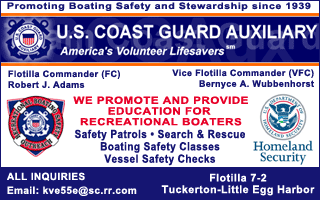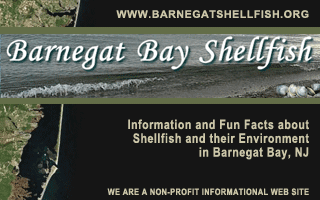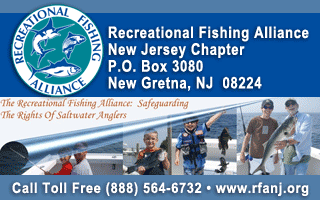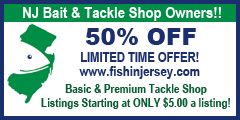

So how quickly can these fish actually adapt to the native food supply? Well, that seems to be open to debate....
by Tom Vassallo
On Saturday, April 5, 2014 at 8 a.m., over 100,000 New Jersey anglers are expected to be lining the banks of New Jersey ponds, lakes, creeks and rivers in search of stocked rainbow, brown and brook trout. Although New Jersey's Pequest Hatchery has suffered through some serious losses due to the furunculosis outbreak, anglers can still expect a huge number of high quality trout to be available throughout the state's stocked waterways. Kudos to our Division of Fish & Wildlife!
To fish for trout or salmon, a valid New Jersey fishing license and trout stamp are BOTH required for residents at least 16 years and less than 70 years of age, plus all non-residents 16 years and older. No person age 16 or older may take, attempt to take (i.e. fish for), or kill trout without a valid fishing license with a trout stamp attached. Therefore, be certain to check the NJ Freshwater Regulations at our link on the navigation bar above. It is the best policy to purchase a trout stamp if you will be fishing in ANY stocked waters in the state of New Jersey.
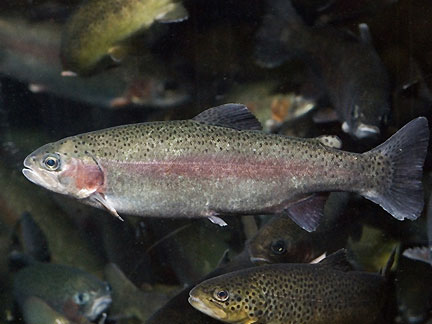 |
| Starting on Saturday, April 5, New Jersey trout anglers will be lining the banks to try their hand at landing one of New Jersey's most sought after freshwater fish. |
Over the years, New Jersey's trout program and hatchery system has done a tremendous job in developing a very respectable trout fishery in our state. Way back in the old days, it was difficult to find many fish that were respectable in size and worth the effort it took to find and catch one. However, the Pequest Hatchery program has been producing hundreds of thousands of beautiful brook, rainbow and brown trout for quite a while now. That is why there are so many NJ anglers so anxious to get a shot at them.
But what always seemed a mystery to me was just exactly what kind of bait is best to catch these hatchery fish? As most of us are aware, as they grow, these fish are raised on a steady diet of brown fish meal pellets. So how quickly can these fish actually adapt to the native food supply? Well, that seems to be open to debate. The NJ Division of Fish & Wildlife coordinates the preseason stocking of hatchery trout beginning about three weeks prior to opening day. There is no way these fish would survive without eating during that period, so we are quite sure that they have somewhat adapted to the available larvae, worms and insects that are a part of the water's natural ecosystem. Those early season trout are going to be a little more adapted to their new homes. But once the season has begun, you can actually fish on stocking days, and those fish are going to be a little more predictable in what they will initially feed upon. You see, back at the hatchery, trout school up in unnaturally large groups since their surroundings are virtually devoid of predators, and they are conditioned to eat those brown, fish-meal pellets. If you were to walk up to a pond with a bucket in your hand, freshly stocked fish might actually come right to you. Once they are released, they will continue to school, swimming in circles while trying to figure out what's food and what's not.
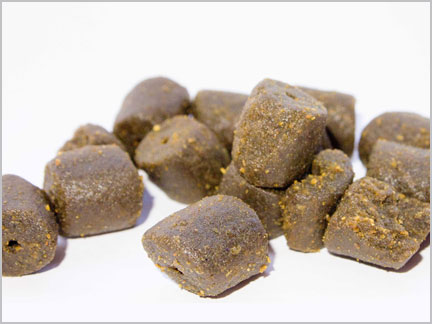 |
| It may not look appetizing to you and look more like something the dog left in your yard, but to hatchery trout...these little nuggets represent a delicious meal! |
Armed with this knowledge, (back in the 1980's) a company named Berkley decided to use it to prey upon what those fish had learned back at the hatchery. They began developing a dough bait that would be purposely concocted to mimic the scent and texture of the very same hatchery meal and pellets that the trout had been raised upon. This dough could be formed into small balls that would resemble the hatchery pellets. The name of that concoction? Berkley PowerBait. The idea was to use a technique that the company referred to as "supermodeling". That concept means to take what an animal knows about its food and to exaggerate some factors with the hope that it will look like something it's eaten before, but even more appealing. PowerBait went on to become a huge success for Berkley, with 100 versions of PowerBait in 200 color variations available to anglers.
Now, way back in the day when I first got into trout fishing, I went out and bought a fly rod, some flies, a new ultralight rod and a bunch of spinners. Sure I caught one here and there, but I wasn't thinking at all about hatcheries and fish meal...and this was certainly WAY before Berkley had even hired its researchers to develop their "PowerBait" dough! (The only time I was using dough was to catch golden roach and catfish!) So you may want to try a new strategy...especially a little later into the season...and especially if you become aware of when some fairly new trout have entered your lake or pond.
Berkley sells this bait in three basic shapes...eggs, nuggets and dough. They sell a shape mold for the dough as well. But what color should you use? Well you could go broke trying to figure that out...especially if you also purchase their "Power Dust" to roll the darn stuff in! But our research uncovered a secret tip from a 2011 interview with Keith Jones, a researcher who worked on the very first "PowerBait" development team.
"Berkley doesn't test to see which color works best, Jones says. But as Berkley's vice president of development consumables, Jones continues to do scent tests on PowerBait. To do so, they use a single color so bait color won't skew their results. That color is a lemony chartreuse chosen because it was easy to make, Jones says. 'I've sat on a dock with a number of other anglers and my catch rates with that color are substantially higher than theirs,' Jones says. But that's one color Berkley doesn't sell."
 |
| Look familiar? These "PowerBait Nuggets" very closely resemble the pellets hatchery trout are fed their entire lifetime in the hatchery. |
However, since this 2011 interview took place, Berkeley now sells a "Gulp" product called a "Trout Nugget". That product comes in a "Chunky Chartreuse" that seems to me to be the color that Mr. Jones was describing in this interview. So if you want to put a little science and logic into your trout fishing this year, it might be worth your while to try out some of these new products... and (believe it or not) Berkley actually sold a discontinued product called "PowerBait Trout Nuggets - Original" that was VERY close to actual hatchery pellets. You may still be able to find some of it online. This product was available in a "cheese" version and an "original version" in the color of...you guessed it...brown!
Now get out there and fish!






